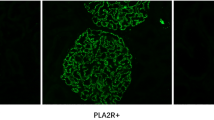Abstract
Purpose
This study evaluated the correlation of anti-β2-glycoprotein I (anti-β2-GPI) antibodies with complement activation in patients with idiopathic membranous nephropathy (IMN).
Methods
Thirty-two IMN patients with positive anti-β2-GPI antibody were enrolled, and 32 age- and sex-matched IMN patients with negative anti-β2-GPI antibody were randomly enrolled as controls. The frozen serum samples of these 64 patients were collected for detection of anti-phospholipase A2 receptor (PLA2R) antibody and the activity of three complement pathways. Paraffin specimens of the kidney tissues of these 64 patients were collected for immunohistochemical staining of C4d.
Results
IMN patients with positive anti-β2-GPI antibody had a significant decline of the residual complement activity of alternative pathway than those with negative anti-β2-GPI antibody (37.4 ± 21.2% vs 65.7 ± 50.5%, P = 0.021). The positive rate of kidney C4d staining in IMN patients with and without anti-β2-GPI was 65.6 and 81.2%, with no significant difference (P = 0.257). Patients with and without anti-β2-GPI had the same positive rate of anti-PLA2R antibody.
Conclusion
Anti-β2-GPI antibody was associated with alternative complement activation in patients with IMN.

Similar content being viewed by others
References
Couser WG (2017) Primary membranous nephropathy. Clin J Am Soc Nephrol 12:983–997
Cattran DC, Brenchley PE (2017) Membranous nephropathy: integrating basic science into improved clinical management. Kidney Int 91:566–574
Beck LH, Bonegio RG, Lambeau G et al (2009) M-type phospholipase A2 receptor as target antigen in idiopathic membranous nephropathy. N Engl J Med 361:11–21
Tomas NM, Beck LH, Meyer-Schwesinger C et al (2014) Thrombospondin type-1 domain-containing 7A in idiopathic membranous nephropathy. N Engl J Med 371:2277–2287
Sethi S, Debiec H, Madden B et al (2020) Neural epidermal growth factor-like 1 protein (NELL-1) associated membranous nephropathy. Kidney Int 97:163–174
Pozdzik A, Brochériou I, David C et al (2018) Membranous nephropathy and anti-podocytes antibodies: implications for the diagnostic workup and disease management. Biomed Res Int 2018:6281054
Ma H, Sandor DG, Beck LH Jr (2013) The role of complement in membranous nephropathy. Semin Nephrol 33:531–542
Francis JM, Beck LH Jr, Salant DJ (2016) Membranous nephropathy: a journey from bench to bedside. Am J Kidney Dis 68:138–147
Salant DJ (2019) Unmet challenges in membranous nephropathy. Curr Opin Nephrol Hypertens 28:70–76
Sciascia S, Radin M (2018) Thrombotic antiphospholipid syndrome. Lupus 27:21–27
Levine JS, Branch DW, Rauch J (2002) The antiphospholipid syndrome. N Engl J Med 346:752–763
Levy Y, Ziporen L, Gilburd B et al (1996) Membranous nephropathy in primary antiphospholipid syndrome: description of a case and induction of renal injury in SCID mice. Hum Antibodies Hybridomas 7:91–96
Sinico RA, Cavazzana I, Nuzzo M et al (2010) Renal involvement in primary antiphospholipid syndrome: retrospective analysis of 160 patients. Clin J Am Soc Nephrol 5:1211–1217
Zhang Q, Wang Y, Xu Y et al (2019) Antiphospholipid antibodies in patients with membranous nephropathy. Nephron 143:228–233
Val-Bernal JF, Garijo MF, Val D et al (2011) C4d immunohistochemical staining is a sensitive method to confirm immunoreactant deposition in formalin-fixed paraffin-embedded tissue in membranous glomerulonephritis. Histol Histopathol 26:1391–1397
Borza DB, Zhang JJ, Beck LH Jr et al (2013) Mouse models of membranous nephropathy: the road less travelled by. Am J Clin Exp Immunol 2:135–145
Jelezarova E, Lutz HU (2005) IgG naturally occurring antibodies stabilize and promote the generation of the alternative complement pathway C3 convertase. Mol Immunol 42:1393–1403
Luo W, Olaru F, Miner JH et al (2018) Alternative pathway is essential for glomerular complement activation and proteinuria in a mouse model of membranous nephropathy. Front Immunol 9:1433
Pierangeli SS, Vega-Ostertag M, Liu X et al (2005) Complement activation: a novel pathogenic mechanism in the antiphospholipid syndrome. Ann N Y Acad Sci 1051:413–420
Ruiz-Irastorza G, Crowther M, Branch W et al (2010) Antiphospholipid syndrome. Lancet 376:1498–1509
Oku K, Atsumi T, Bohgaki M et al (2009) Complement activation in patients with primary antiphospholipid syndrome. Ann Rheum Dis 68:1030–1035
Zhou Y, Chen P, Li Y (2019) Association between antiphospholipid antibodies and factor Bb in lupus nephritis patients with glomerular microthrombosis. Int J Rheum Dis 22:2185–2190
Lionaki S, Derebail VK, Hogan SL et al (2012) Venous thromboembolism in patients with membranous nephropathy. Clin J Am Soc Nephrol 7:43–51
Barbour SJ, Greenwald A, Djurdjev O et al (2012) Disease-specific risk of venous thromboembolic events is increased in idiopathic glomerulonephritis. Kidney Int 81:190–195
Acknowledgement
This study was supported by the funds from Primary Research & Development plan of Zhejiang Province (2020C03034) to Fei Han, Zhejiang Medical and Health Science and Technology Project (2019RC036) to Lan Lan and Project of Natural Science Foundation of Zhejiang Province (Q19H050030) to Pingping Ren.
Author information
Authors and Affiliations
Corresponding author
Additional information
Publisher's Note
Springer Nature remains neutral with regard to jurisdictional claims in published maps and institutional affiliations.
Rights and permissions
About this article
Cite this article
Zhang, Q., Wang, Y., Ma, Y. et al. The correlation of anti-β2-glycoprotein I antibody with complement activation in patients with idiopathic membranous nephropathy. Int Urol Nephrol 53, 955–959 (2021). https://doi.org/10.1007/s11255-020-02698-2
Received:
Accepted:
Published:
Issue Date:
DOI: https://doi.org/10.1007/s11255-020-02698-2




